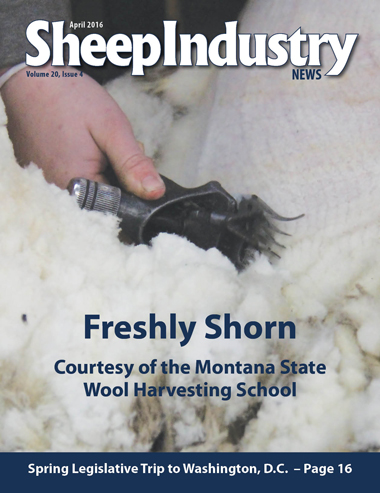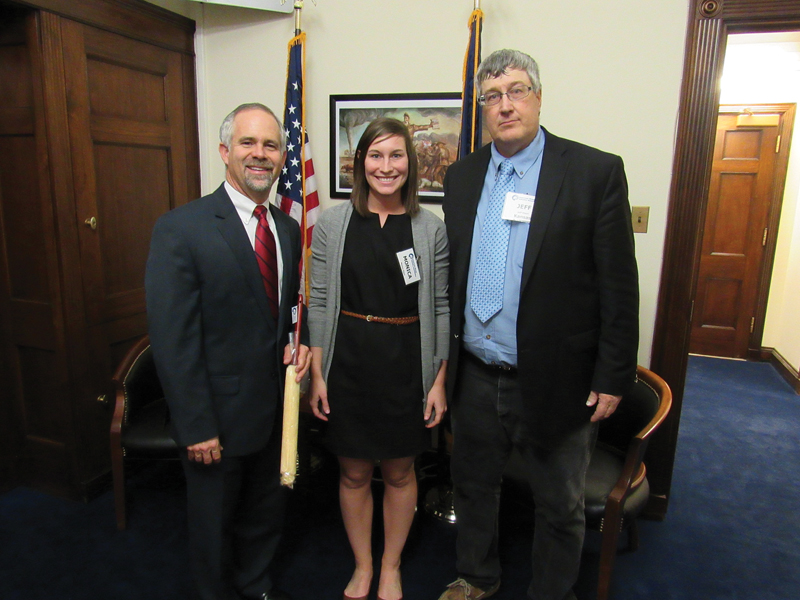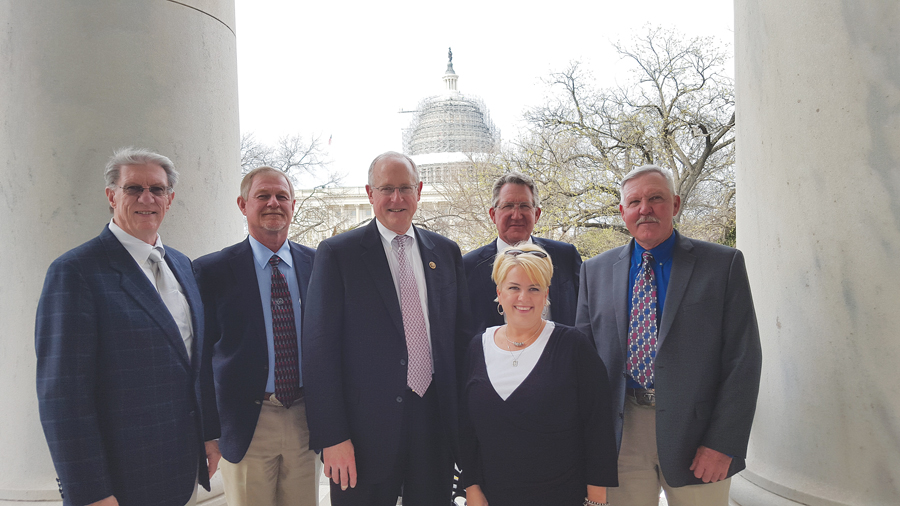
- April 2016
- President’s Notes
- ASI Legislative Trip
- Sage Grouse Discussion
- Changes for Price Reporting
- Shearing 101 in Montana
- Science of Bighorn Report Questioned
- USSES Reports Available
- American Lamb Board Vacancies for 2017
- Market Report
- NLFA Leadership School in Ohio
- Sheep Heritage Foundation Scholarship
- Around the States
- The Last Word
ASI Annual Legislative Trip
Sheep Industry Well Represented in D.C. Visit
JUDY MALONE
ASI Director of Industry Information
American lamb could be flowing into Japan by this summer. That was one of the top announcements received by the more than 50 ASI attendees from 17 states who spent time in Washington, D.C., on March 14-17 to discuss industry issues with multiple agencies at the U.S. Department of Agriculture.
 Agricultural Research Services Associate Administrator Simon Liu, Ph.D., explained the past and current budget situation, as well as gave a snapshot of the more than $1 billion intramural research agency’s staffing and scope.
Agricultural Research Services Associate Administrator Simon Liu, Ph.D., explained the past and current budget situation, as well as gave a snapshot of the more than $1 billion intramural research agency’s staffing and scope.
Steven Kappes, Ph.D., deputy administrator, discussed some research outcomes from the U.S. Sheep Experiment Station, the Animal Disease Research Unit and the Meat Animal Research Center. Highlights included the development of selection tools to identify early sexual maturity in ewe lambs; genomic tools to control Ovine Progressive Pneumonia and scrapie; an infection response gene in bighorn sheep; a new Coxiella initiative; salmonella screening for antimicrobial resistance and easy-care sheep.
The group reminded Liu and Kappes that correcting funding and staffing at USSES and staffing at MARC are critically important to provide research information and, thus, competitiveness to the U.S. sheep industry.
“Welcome to your nation’s capital,” said Craig Morris, Ph.D., deputy director for Agricultural Marketing Service’s Livestock, Poultry and Seed Program. In a progress report to industry leaders, Morris updated the room on the American Lamb Board, the National Sheep Industry Improvement Center, meat quality assessment, procurement, market news and mandatory price reporting.
The lamb board will have four vacancies for fiscal year 2017. Nominations are due by May 16. As a result of a resignation on the 2016 board, one additional first handler position is open and nominations are due to AMS by April 15 for this position. Producers interested in being nominated can contact ASI.
NSIIC has just more than $1 million is reserves to grant and will soon be accepting applications in its next round of funding. The nomination period for positions on this board will be announced in April.
Superior Farms is working with a company in Germany to perfect the camera that is being used in its plant for electronic grading of lamb carcasses. Mountain States Rosen is also pursuing the use of this technology.
The Section 32 lamb buy moved away from purchasing just legs and roasts to buying lamb shanks for the first time in 2015 with good feedback from the recipients. The lamb program is unique from other commodity buys in that ALB places lamb recipes in with the product for the end user. Through June 15 of this year, 920,000 pounds of lamb will be delivered to food banks across the country. As long as the program continues to show an advantage to the industry, it can remain a tool in the tool-chest for producers.
Livestock Mandatory Price Reporting was reauthorized in 2015 for an additional five years. AMS currently captures nearly 50 percent of all domestic lamb prices. The industry has until April 29 to comment on the direct final rule and a proposed rule that are now out for comment. Some of the highlights include: modifications of the definition of a packer and that of an importer, the definition for packer owned lambs, lambs committed for delivery and a new lamb-pelt reporting provision. A Feb. 26 ASI Weekly Newsletter article explains the details (Sheepusa.org/NewsMedia_WeeklyNewsletter_2016_February_February262016_MandatoryReportingRevisionsOpenForComment).
Wildlife Services received an $11 million budget increase in fiscal year 2015 to fund aviation, a national training center and work on feral swine control and aquaculture protection, according to Bill Clay, WS deputy administrator.
 His agency is in its last year of testing new breeds of livestock protection dogs introduced from the European Union. There are 19 producers across five states using the dogs to protect 21 bands of sheep against mountain lions, coyotes, bear and wolves. The larger dogs look to be effective, but the final analysis will not be available until after this grazing season.
His agency is in its last year of testing new breeds of livestock protection dogs introduced from the European Union. There are 19 producers across five states using the dogs to protect 21 bands of sheep against mountain lions, coyotes, bear and wolves. The larger dogs look to be effective, but the final analysis will not be available until after this grazing season.
A bright spot for the WS agency was the result of an Office of the Inspector General audit. Critics of the program accused it of not engaging ranchers in the use of non-lethal protection, under-reporting predator takes and incorrectly handling and storing hazardous materials, all of which were proven inaccurate in the audit.
“This was one of the most positive reports to come out of OIG,” boasted Clay.
Anne Dawson, senior policy advisor for the Animal Division of the Foreign Agricultural Service announced to the group that if all goes as anticipated, lamb markets to Japan could be open by July or August. There will likely be an export verification program required that includes a “specified risk materials” ban that is consistent with EU protocols.
“The goal in opening the Japanese market for lamb is to get the U.S. system approved, not just one processor,” stated Dawson, “and it looks like that will be the outcome.”
The Taiwan market is also very close to being open and FAS is hoping the agreement will be finalized in the first half of 2016. South Korea is in the early stages, with the United States entertaining a questionnaire.
“Every sheep producer in the United States is impacted by scrapie,” began Alan Huddleston, DVM, Associate National Scrapie Program Coordinator with USDA’s Animal and Plant Health Inspection Service. “Several years ago, scrapie cost sheep producers between $10 and $20 million annually in profit because of market access limitations.”
Key elements to the scrapie eradication program that have helped in its success are the provision of free ear tags to build compliance and the creation of a slaughter surveillance program where 40,000 to 45,000 animals are tested each year.
With a flat budget in fiscal year 2017, it will be difficult to reach all the corners of the industry for surveillance and eradicate scrapie in a timely manner.
“Therefore, I would suggest increased identification to assist with surveillance to reduce prevalence as the way to identify the last remaining cases of scrapie and be able to eventually certify the United States as scrapie free,” concluded Huddleston.

